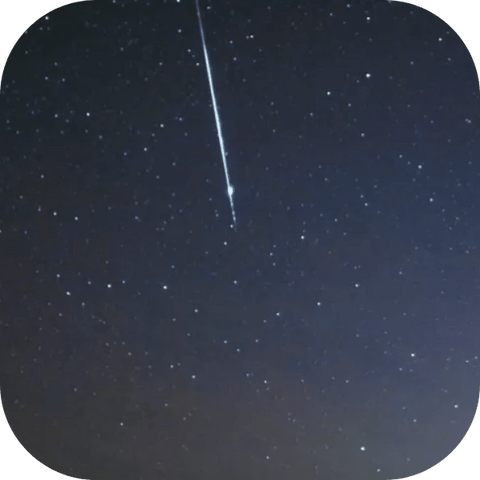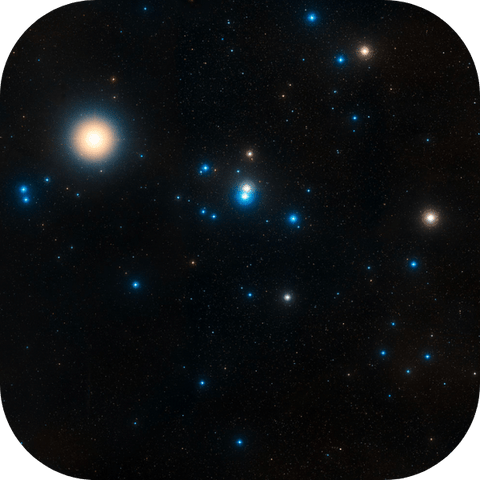November celestial activity begins with a Jupiter opposition on the 3rd and Asteroid 18 Melpomene opposition on the 5th. Shortly after, the Northern Taurid meteor shower peaks on the 12th. This occurs a day before the third opposition of the month with Uranus.
At 15 meteors per hour, the Leonids meteor shower peaks on the 18th. On this same day, the Pleiades star cluster is well placed in the night sky reaching its highest point.
Finally, the month wraps up with the Full Beaver Moon on the 27th and a day later the Hyades star cluster is well placed for observation.
(Looking to review last month's astronomy events? View October 2023)
Our highlighted list of astronomy events for November serves as your reference for key celestial targets to plan for.
8 Astronomical Events in November 2023:
- Jupiter at opposition - 11/3
- Asteroid 18 Melpomene at opposition - 11/5
- Northern Taurid meteor shower peak - 11/12
- Uranus at opposition - 11/13
- Leonid meteor shower peak - 11/18
- The Pleiades cluster is well placed - 11/18
- Full Beavers Moon - 11/27
- The Hyades cluster is well placed - 11/28
For easy navigation, click an event listed above to go directly to that section of the article. Below, we will explore each of these events in greater detail.
Astronomy events to mark on your November 2023 calendar:
November 3rd - Jupiter at opposition

On Friday, November 3rd, Jupiter will be at opposition and will reach its highest point in the sky around midnight local time.
A celestial object "at opposition" refers to its 180° position opposite to the Sun. During this alignment Jupiter will rise at around sunset, and set at around sunrise.
Jupiter will be at a distance of 3.98 AU, shining at magnitude -2.9 in the Aries constellation. It will measure 48.4 arcsec in diameter. A small aperture telescope or a pair of binoculars will help you observe our solar system's largest planet.
Jupiter at opposition
- Magnitude: -2.9
- Right ascension: 02h32m50s
- Declination: 13°31'N
- Constellation: Aries
- Angular size: 48.4"
November 5th - Asteroid 18 Melpomene at opposition

On Sunday, November 5th, Asteroid 18 Melpomene will be at opposition and will reach its highest point in the sky around midnight local time.
A celestial object "at opposition" refers to its 180° position opposite to the Sun. During this alignment Melpomene will rise at around sunset, and set at around sunrise.
Melpomene will be at a distance of .863 AU, shining at magnitude +8.0 in the Eridanus constellation. A moderate aperture telescope or a pair of binoculars should be used to help you properly observe this planet.
Melpomene at opposition
- Magnitude: +8.0
- Right ascension: 03h07m40s
- Declination: 4°05'S
- Constellation: Eridanus
November 12th - Northern Taurid meteor shower peak

The Northern Taurid meteor shower is active from October 13th to December 2nd. It reaches its peak on Sunday, November 12th. Its radiant point, the area from which the shower appears to emanate, is positioned in the Taurus constellation around right ascension 05h50m and declination 22°N.
According to the American Meteor Society, this meteor shower's ZHR will be approximately 5 meteors per hour. ZHR is an abbreviation for Zenithal Hourly Rate and is defined as the hourly rate at which a meteor shower produces with a clear, dark sky, and with the radiant at the zenith (highest point directly above the observer).
The parent body responsible for creating the Northern Taurid shower is comet 2P/Encke.
Tips for viewing meteor showers:
- Do not direct your gaze solely at the radiant point. The closer a meteor is in proximity to its radiant point, the more difficult it is to see because of its shorter trail.
- Position yourself in a dark, secluded location away from light pollution and bright city lights.
- Allow for up to 30 minutes for your eyes to properly adjust to the dark environment.
- Make sure to dress appropriately for the weather.
- Bring a comfortable lawn chair in which you can recline or a blanket to lie back on.
- Try to observe as wide an area of the sky as possible. The broader your view of the sky, the greater the chance of catching a glimpse of a meteor whizzing by.
November 13th - Uranus at opposition

On Monday, November 13th, Uranus will be at opposition and reach its highest point in the sky around midnight local time.
A celestial object "at opposition" refers to its 180° position opposite to the Sun. During this alignment Uranus will rise at around sunset, and set at around sunrise.
Uranus will be at a distance of 18.63 AU, shining at magnitude +5.6 in the Aries constellation. It will measure 3.8 arcsec in diameter. A small aperture telescope or a pair of binoculars will help you observe the largest planet in the solar system.
Uranus at opposition
- Magnitude: +5.6
- Right ascension: 03h13m30s
- Declination: 17°37'N
- Constellation: Aries
- Angular size: 3.8"
November 18th - Leonid meteor shower peak

The Leonid meteor shower is active from November 3rd to December 2nd. It reaches its peak on Saturday, November 18th. Its radiant point, the area from which the shower appears to emanate, is positioned in the Leo constellation around right ascension 10h00m and declination 22°N.
According to the American Meteor Society, this meteor shower's ZHR will be approximately 15 meteors per hour. ZHR is an abbreviation for Zenithal Hourly Rate and is defined as the hourly rate at which a meteor shower produces with a clear, dark sky, and with the radiant at the zenith (highest point directly above the observer).
The parent body responsible for creating the Leonid shower is comet 55P/Tempel-Tuttle.
November 18th - The Pleiades cluster is well placed

The Pleiades cluster, also known as M45, will reach its highest point in the sky at around midnight local time on Saturday, November 18th.
This open star cluster is visible to the naked eye. However, the use of a small aperture telescope or a pair of binoculars will provide the best views.
M45 is the nearest Messier object and lies approximately 444 light-years from Earth.
Pleiades cluster on 11/18
- Magnitude: +1.3
- Right ascension: 03h47m30s
- Declination: 24°06'N
- Constellation: Taurus
November 27th - Full Moon | Beavers Moon

On Monday, November 27th, the Moon will reach the full phase of its 29.5 day lunar cycle rising at around dusk and setting at around dawn. This astronomical event occurs each time the Moon's ecliptic longitude appears 180° away from the Sun's ecliptic longitude.
According to the Farmers' Almanac, traditionally the Full Moon that occurs during this time of year is referred to as the Beavers Moon. It is believed that the name originates from the observation of beavers taking shelter at this time.
Full Beavers Moon
- Right ascension: 04h07m30s
- Declination: 24°20'N
- Constellation: Taurus
- Angular size: 31'23"
- Distance from Earth: 380,000 km (236,121 miles)
November 28th - The Hyades cluster is well placed

On Tuesday, November 28th, the Hyades cluster will reach its highest point in the sky at around midnight local time.
Shining at magnitude +1.0, Hyades is visible with the naked eye. With a small aperture telescope or a pair of binoculars you will better observe this open star cluster.
The Hyades cluster, sometimes referred to as Caldwell 41, is located approximately 153 light-years from Earth.
Hyades cluster on 11/28
- Magnitude: +1.0
- Right ascension: 04h27m00s
- Declination: 16°00'N
- Constellation: Taurus
Plan your observations
Now that you know which celestial events are occurring in the night sky this month, make sure to plan for your observation sessions. Some of the events discussed above can be seen without any special optical equipment. However, a quality pair of binoculars or a premium telescope will significantly enhance your viewing experience.
If you're in the market for purchasing or upgrading your astronomy gear, we have a curated selection of binoculars, telescopes and accessories from which to choose. Our online store offers high quality optics from industry-leading brands at value prices to help you explore the world above.
Feel free to browse our telescope collection or browse our binoculars.
If you are not sure where to begin, you may read our blog post How To Choose The Right Telescope or How To Choose The Right Binoculars for additional guidance.


